Coronavirus (COVID-19): state of the epidemic - 2 July 2021
This report brings together the different sources of evidence and data about the coronavirus epidemic to summarise the current situation, why we are at that place, and what is likely to happen next.
State of the Epidemic in Scotland – 2nd July 2021
Background
This report summarises the current situation on the Covid-19 epidemic in Scotland. It brings together the different sources of evidence and data about the epidemic in Scotland at this point in time, why we are at that place, and what is likely to happen next. This summarises the data up to and including 1 July 2021 on Covid-19 in Scotland. This updates the previous publication published on 25 June 2021[1]. The information in this document helps the Scottish Government, the health service and the wider public sector respond to the epidemic and put in place what is needed to keep us safe and treat people who have the virus.
This edition of the State of the Epidemic summarises current data on Covid-19 at a national and local level, and how Scotland currently compares to the rest of the UK. It looks at the vaccination program in Scotland and the effects that are beginning to be seen from this. Information is provided about variants of concern and what impact these may have. Bringing this information together in one place gives the opportunity to better understand the current state of the epidemic in Scotland.
Key Points
- The reproduction rate R in Scotland is currently estimated as being between 1.2 and 1.5, based on data up until the 28th June. This has increased since last week. The R and growth rate indicators lag by two to three weeks, as a result the estimates cannot fully reflect the significant increase in daily cases seen over the past week.
- An average of 3,107 cases were reported per day in the 7 days to 1 July, which is a 71% increase in reported cases since the 24 June.
- There were 375 weekly cases per 100,000 in the week to 28 June, which is an increase since last week. This compares to 302 weekly cases per 100,000 on 8 January and is the highest case rate recorded in Scotland since the start of the pandemic.
- Case rates saw a rise amongst all age bands over the last week. The highest case rates were observed amongst 20-39, followed by 0-19, 40-59, 60-79 and 80+ this week.
- As determined through the latest weekly ONS survey, the estimated proportion of people becoming infected with Covid in the community in Scotland has continued to increase in the most recent week. Scotland is currently above England, Wales and Northern Ireland.
- Latest modelled estimates suggest there are currently between 48 and 76 new daily infections per 100,000 people in Scotland.
- There were 17 deaths registered in Scotland where coronavirus was mentioned on the death certificate in the week ending 27 June. Deaths have increased in those aged 45-64 (from 0 to 1 death), 65-74 (from 2 to 5 deaths) and 75-84 (from 2 to 8 deaths) over the 3 weeks to 27 June. COVID deaths declined a little in those aged 85+ (from 3 to 2 deaths) over this period.
- Average daily deaths per 100,000 population in Scotland (0.04) are above England (0.02), Wales (0.01) and Northern Ireland (0.00).
- Dundee currently has the highest weekly case rate in Scotland reporting 788 cases per 100,000 in the week to 28 June, followed by Midlothian with 676 weekly cases per 100,000 East Lothian with 624 weekly cases per 100,000. There were 25 other local authorities reporting over a 100 weekly cases per 100,000 population in the last week. Na h-Eileanan Siar reported 7 weekly cases per 100,000 in the same period.
- Modelled rates of positive tests per 100,000 population using data to 28th June indicate that for the week commencing 11th July 2021, there are 28 local authorities with at least a 75% probability of exceeding 150 cases. Of these, 19 local authorities have at least a 75% probability of exceeding 500 cases per 100,000. These are Aberdeen, Aberdeenshire, Angus, Edinburgh, Dundee, East Ayrshire, East Dunbartonshire, East Lothian, Falkirk, Fife, Glasgow, Midlothian, North Ayrshire, North Lanarkshire, Perth and Kinross, Renfrewshire, South Lanarkshire, West Dunbartonshire and West Lothian. There are 4 local authorities with at least a 75% probability of exceeding 1000 cases per 100,000. These are Dundee, Edinburgh, Fife and Glasgow. Of these, Edinburgh is expected to exceed 2000 cases per 100,000 with at least a 75% probability.
- The overall level of wastewater (WW) Covid-19 rose rapidly in the last week.
- Based on the recent increase in cases, infections, hospital beds and ICU are projected to rise – how long this continues for is uncertain. Following the recent increase in cases, projections of a continued growth in the epidemic in Scotland, are with considerable uncertainty as to what this means for future weeks.
- Over 3.8 million people in Scotland have been given a first vaccine against SARS-CoV-2, and over 2.7 million have now received a second dose.
- The Delta variant of concern, (VOC-21APR-02, first identified in India), is now the dominant strain in Scotland.
Method
This report brings together a wide range of publically available figures from a range of data sources. These include publications by Scottish Government, Public Heath Scotland, National Records of Scotland and Office for National Statistics along with scientific publications and SAGE summaries where appropriate to summarise the state of the epidemic in Scotland in a given week. We also provide information on public attitudes to the virus from weekly YouGov polling surveys.
The national picture
The latest R value for Scotland (published on 1 July and based on data up to 28 June)[2] was between 1.2 and 1.5 (Figure 1), with a growth rate of between 3% and 7%. The R and growth rate indicators lag by two to three weeks, as a result the estimates cannot fully reflect the significant increase in daily cases seen over the past week.
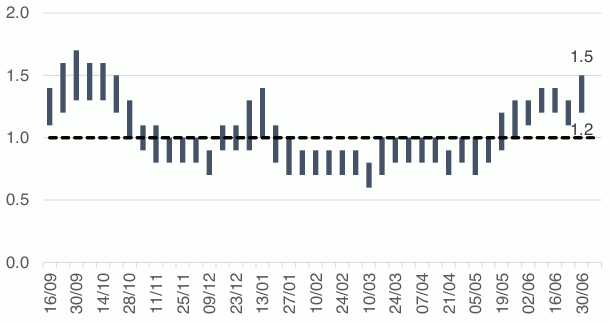
An average of 3,107 cases were reported per day in the 7 days to 1 July. This is a 71% increase from the daily average cases recorded a week earlier to 24 June[3]. Average daily cases reported are 34% higher than the peak of 2,323 in the week to 7 January. Our current position is 375 weekly cases per 100,000 in the week to 28 June[4]. This compares to 302 weekly cases per 100,000 on 8 January (see Figure 2) and is the highest case rate recorded in Scotland since the start of the pandemic[4].
Following PHS analysis, 1,991 people resident in Scotland with a
laboratory-confirmed COVID-19 diagnosis were identified as having attended one or more Euro 2020 events during their infectious period (a time in which they may have unknowingly transmitted their infection to others) between 11-28 June 2021[5]. Almost 74% (1,470 cases) of these were of 20-39 year olds[5].
The number of locations where the levels of Covid in wastewater are monitored has increased to 110 sites around Scotland. In contrast to Covid-19 case records, virus shedding into wastewater is a biological process. This means that wastewater data is unaffected by factors that impact whether testing is done. The level of wastewater Covid-19 has increased rapidly in the last week.
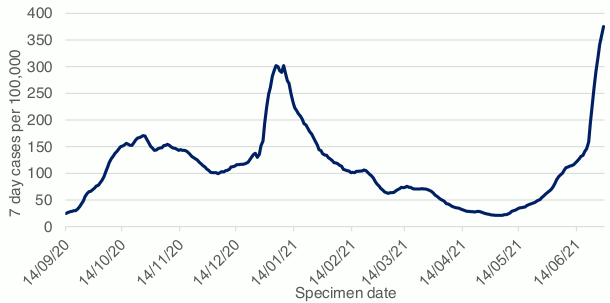
Case rates have risen across all age bands this week, with the highest case rates similarly to last week currently being reported in those aged 20-39 followed by 0-19, 40-59, 60-79 and 80+ (Figure 3).
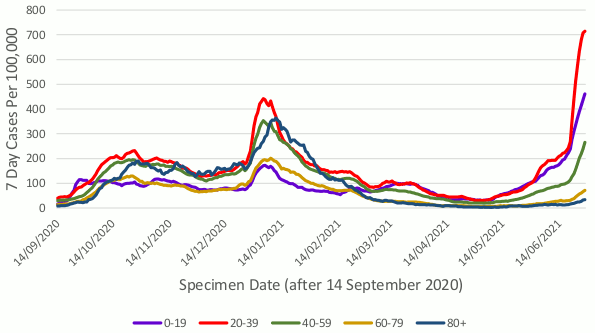
Not everyone who has the virus will be tested, as many people do not realise they have Covid, or they have mild symptoms and do not come forward. Latest modelled estimates, based on data up to 28 June, suggest there are currently anywhere between 2,600 and 4,200 people infected in Scotland each day[2]. This means that as of 30 June there were between 48 and 76 new daily infections per 100,000 people.
The number of people in hospital with confirmed Covid for less than 28 days has started to increase. After peaking at 2,053 on 22 January, this figure decreased to a low of 58 on 6 May. This has since increased and as of 1 July there were 275 patients in hospital with Covid-19. Daily hospital admissions for people with Covid follow a similar pattern, having decreased from a peak of 241 on 11 January to a low of 4 on 28 April, and have since increased to 29 on 27 June[7].
There were 17 deaths registered where Covid was mentioned on the death certificate in the week to 27 June. This is slightly higher than the 13 deaths the week before (+31%), and 97% lower than the peak in April 2020 (663 deaths). The proportion of deaths in care homes decreased from 60% in April 2020 to between 0% and 25% of Covid deaths from 3 May to 6 June 2021. In the most recent week ending 27 June, no deaths occurred in care homes. Deaths involving coronavirus have increased in those aged 45-64 (from 0 to 1 death), 65-74 (from 2 to 5 deaths) and 75-84 (from 2 to 8 deaths) over the 3 weeks to 27 June[8] (Figure 4). Deaths decreased from 3 to 2 weekly deaths in the over 85s over the same period. However, this variation in age and location is expected when death numbers are low.
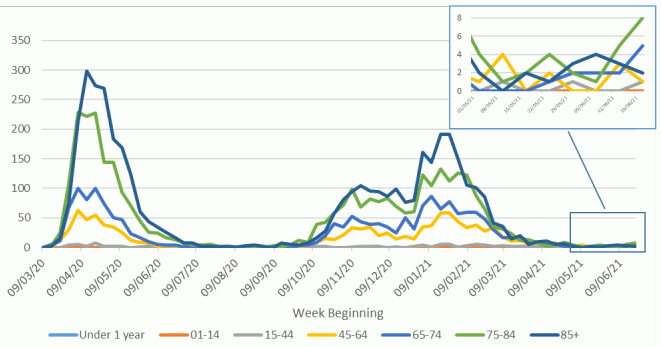
How Scotland compares with the rest of the UK
The latest ONS survey estimates that the proportion of the population infected in the community in Scotland (0.68% of people currently testing positive for Covid-19 from 20 to 26 June) has continued to increase in the most recent week. The estimation is above England (0.39%), Northern Ireland (0.15%) and Wales (0.22%). In the week to 26 June the estimated rate of community infection was 1 in 150 people in Scotland, compared to 1 in 260 for England, 1 in 670 for Northern Ireland and 1 in 450 for Wales[9]. Average daily deaths in Scotland (0.04 per 100,000 in the week to 1 July) are above England (0.02), Wales (0.01) and Northern Ireland (0.00). The Coronavirus Infection Survey estimated that in the week beginning 7 June 2021, 79.1% of the adult population in Scotland would have tested positive for antibodies against Covid-19, as a result of having the infection in the past or being vaccinated. This compares to 86.6% in England, 88.7% in Wales and 85.4% in Northern Ireland[10].
81,000 people in Scotland (1.53% of the respective population) living in private households were experiencing self-reported long COVID symptoms for any duration as of 6 June 2021. This compares to 1.51% in England, 1.41% in Wales and 0.97% in Northern Ireland[11].
Following the ONS analysis of new positive infection after COVID-19 vaccination at the UK level, 0.5% of those who had been vaccinated had a new infection after vaccination to 31 May 2021. A lower proportion (0.1%) tested positive after two vaccinations[12].
Situation by local authority within Scotland
Dundee currently has the highest case rate in Scotland with 788 weekly cases reported per 100,000 in the week to 28 June, which is a 106% increase from the week to 21 June[4]. It is followed by Midlothian with 676 weekly cases per 100,000, and East Lothian with 624 cases per 100,000 population. In the week to 28 June there were 25 other local authorities reporting over a 100 weekly cases per 100,000 population (Table 1). There are mostly very high levels of cases across Scotland (Figure 5). All local authorities, except for Shetland, recorded an increase in cases per 100,000 population over the last week. Na h-Eileanan Siar has the lowest case rate in Scotland, reporting 7 weekly cases to 28 June[4].
| Local authority | Total new weekly cases per 100,000 population (28 June) | Change since previous week (21 June ) |
|---|---|---|
| Dundee City | 788 | +405 |
| Midlothian | 676 | +374 |
| East Lothian | 624 | +231 |
| City of Edinburgh | 585 | +248 |
| Renfrewshire | 486 | +293 |
| East Ayrshire | 455 | +176 |
| West Dunbartonshire | 454 | +201 |
| East Dunbartonshire | 431 | +196 |
| East Renfrewshire | 430 | +223 |
| Angus | 423 | +286 |
| Glasgow City | 411 | +195 |
| Fife | 375 | +257 |
| Perth and Kinross | 363 | +143 |
| West Lothian | 359 | +195 |
| Aberdeen City | 357 | +185 |
| North Lanarkshire | 351 | +173 |
| Falkirk | 331 | +208 |
| South Lanarkshire | 279 | +81 |
| Clackmannanshire | 277 | +114 |
| Inverclyde | 276 | +125 |
| Stirling | 269 | +162 |
| Scottish Borders | 265 | +77 |
| North Ayrshire | 248 | +34 |
| South Ayrshire | 247 | +78 |
| Argyll and Bute | 235 | +35 |
| Highland | 218 | +167 |
| Aberdeenshire | 185 | +90 |
| Dumfries and Galloway | 144 | +72 |
| Moray | 70 | +49 |
| Shetland Islands | 57 | 0 |
| Orkney Islands | 40 | +18 |
| Na h-Eileanan Siar | 7 | +7 |
| Scotland | 375 | +182 |
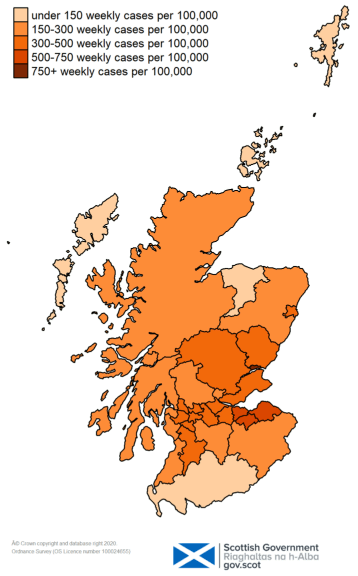
The most recent modelling predicts, based on data up to 28th June, that for the week ending 17 July there are 28 local authorities that have at least a 75% probability of exceeding 150 cases per 100,000 population. Of those, 19 local authorities have at least a 75% probability of exceeding 500 cases (Aberdeen, Aberdeenshire, Angus, Edinburgh, Dundee, East Ayrshire, East Dunbartonshire, East Lothian, Falkirk, Fife, Glasgow, Midlothian, North Ayrshire, North Lanarkshire, Perth and Kinross, Renfrewshire, South Lanarkshire, West Dunbartonshire and West Lothian) and 4 local authorities (Dundee, Edinburgh, Fife and Glasgow) have at least a 75% probability of exceeding 1000 cases per 100,000 (Figure 6)[2].
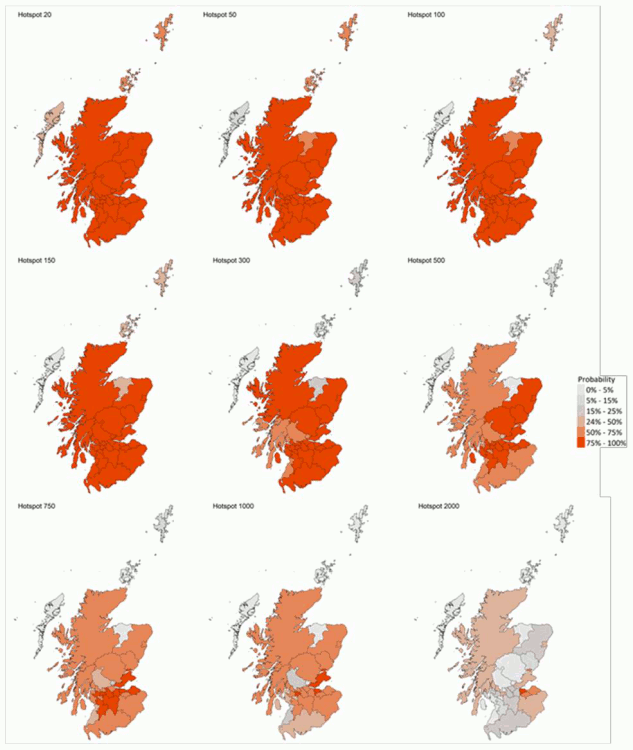
Children and Education
Over the last week there was a further increase in the total number of COVID-19 cases in young people, which has gone up from 2,658 cases in the week to 20 June to 4,852 cases in the week ending 27 June. 7 day cases per 100,000 have also increased in all age groups in the week ending 27 June (Figure 7). The percentage of cases made up of children under 12 was just over 35% (1,719 cases) compared to just over 46% (1,239 cases) in the previous week[13].
The rate of testing increased amongst all age groups in the week ending 27 June. Test positivity rates increased amongst all age groups in the same period[13]. The proportion of positive cases who report having been in an education setting in the 7 day period prior to the onset of symptoms has decreased to 10.5% in week ending 27 June, from 19.1% of positive cases in the previous week. Hospital admissions amongst children continue to increase, with a 3-week rolling average of 3.3 admissions for 2-4 year olds, 5.0 for 5-11 year olds, and 3.0 for 12-17 year olds up to 23 June[13]. These are now higher than levels seen in December and late January and compares to 3.7 among 2-4 year olds, 3.7 among 5-11 year olds and 3.3 among 12-17 year olds in the period ending 16 June.
This section will not be updated in the coming weeks due to school summer holidays.
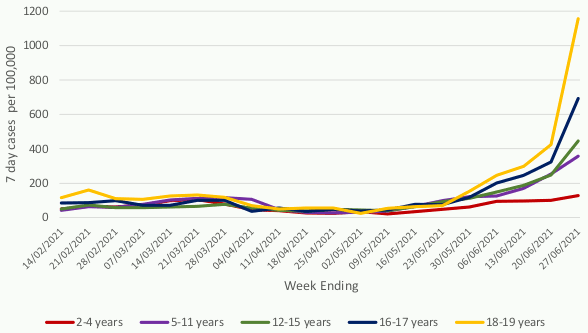
Looking ahead
Changes in patterns of mixing and adherence to restrictions will impact on future case numbers. The Scottish Contact Survey measures times and settings that people mix where they could potentially spread Covid[2]. From this survey we can say that average contacts have increased slightly (6%) in the last two weeks (comparing surveys pertaining to 3rd June - 9th June and 17th June - 23rd June) with a current level of 4.6 daily contacts. Contacts within the school setting were 3 times higher than reported two weeks prior and contacts within the other setting (contacts outside of the school, home and work) have increased by 7%. Average contacts within the home and work setting have remained at similar levels over the same period. Those aged under 40 have shown the biggest increase in mean contacts in the last two weeks, increasing by at least 33%. These increases are largely driven by contacts within the school and work settings. Average contacts for those aged over 70 have also increased, although to a lesser extent (15%), which is influenced by an increase in contacts within a school or other (contacts outside of the school work or home) setting. The biggest increase in interactions is seen with those aged between 18-39 with those aged under 18 whereas those aged between 40-49 have reported the biggest reductions in interactions with those under 18.
Self-reported compliance with the current regulations and guidance has decreased since January but remains at a high level. On 29-30 June, 66% of people reported ‘complete’ or ‘almost complete’ compliance[14].
Based on the recent increase in cases, infections, hospital beds and ICU are projected to rise – how long this continues for is uncertain (Figure 8[2]). Following the recent increase in cases, projections of a continued growth in the epidemic in Scotland, are with considerable uncertainty as to what this means for future weeks.
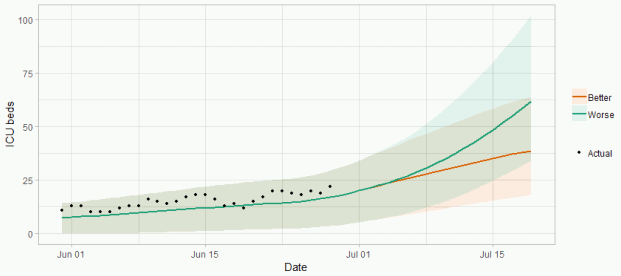
Vaccinations are continuing across the priority groups and 85.6% of the adult population in Scotland has now been vaccinated with the first dose[6]. The first vaccines were administered on Tuesday 8 December and 3,816,251 people had received their first dose by 1 July 2021, a 3% increase from 24 June[3]. By age group, almost 100% of individuals aged 55+, 94% of those aged 50-54, 89% of those aged 40-49, 78% of those aged 30-39 have received their first vaccination (Figure 9). 95% of the over 80s, 99% of those aged 75-79, 100% of those aged 70-74, 98% of those aged 65-69, 99% of those aged 60-64, 95% of those aged 55-59 and 86% of those aged 50-54 have received their second dose. Overall, 2,722,725 people (61.2% of those aged 18 and over) had received their second dose by 1 July[6]. There remains low levels of hospitalisations and deaths among those groups vaccinated first (Figure 4).
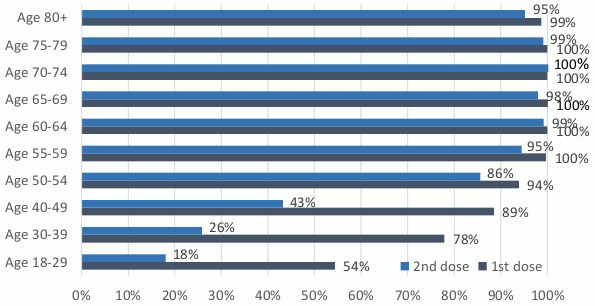
The proportion of people surveyed who said they would be likely to be vaccinated for Covid-19 remains relatively high. 88% of all respondents have already received at least their first vaccine dose. Of those not vaccinated, 30% report they are likely to be vaccinated when a vaccine becomes available to them[16].
How the virus is changing
The variant of concern Delta, also referred to as VOC-21APR-02 (first identified in India) is spreading rapidly and has fast replaced Alpha
(VOC-20DEC-01, first identified in the UK) as the dominant strain in Scotland, and 10,185 cases have now been sequenced as Delta to 30 June 2021.
To date there are five ‘variants of concern’ (VOCs) and eight ‘variants under investigation’ (VUIs)[17]. There is a concern that some of these new variants may partially escape immunity, from both natural infection and from vaccines currently being deployed, and we are monitoring the evidence on this[18] [19] [20]. Up to 30 June there have been 55 genomically confirmed cases of the variant Beta/VOC-20DEC-02 (first seen in South Africa) in Scotland, no increase since last week. Genomically confirmed cases of other VOCs and VUIs remains low, there have been no new cases of VOCs or VUIs in the last week (Figure 10).
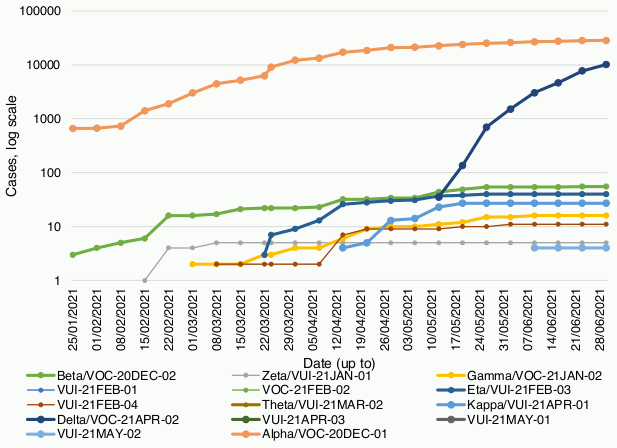
The Delta/VOC-21APR-02 variant is more transmissible than Alpha/VOC-20DEC-01[22] [23] and R is currently estimated to be 40–80% higher for delta than for alpha (B.1.1.7), although this is highly uncertain[24]. The secondary attack rates for contacts of cases with Delta/VOC-21APR-02 and no travel history are higher than those for contacts of non-travel cases with Alpha/VOC-20DEC-01[25]. Public Health England recent study shows that after a single dose there was an 14% absolute reduction in vaccine effectiveness against symptomatic disease with Delta compared to Alpha, and a smaller 10% reduction in effectiveness after 2 doses[26], which is in line with previous studies[27]. Public Health England preliminary analysis also shows that vaccines highly effective against hospitalisation from Delta variant[28] with similar vaccine effectiveness against hospitalisation seen with the Alpha and Delta variants[29]. EAVE II data from Scotland also shows that both the Oxford–AstraZeneca and Pfizer–BioNTech COVID-19 vaccines are effective in reducing the risk of SARS-CoV-2 infection and COVID-19 hospitalisation in people with the Delta variant, but these effects on infection appeared to be diminished when compared to those with the Alpha VOC[30].
There remains uncertainty regarding the impact of the Delta variant on severity of illness, treatment or reinfections. Updated Risk Assessment for Delta variant suggests that vaccine effectiveness against hospitalisation is maintained[22]. Current data from the EAVEII project shows that compared to the Alpha variant, the Delta variant is associated with an increase in the risk of Covid-19 hospitalisation in Scotland by 85% (95% CI 39-147)[31]. As more data is analysed we shall become more certain of the impact of Delta on hospitalisations and disease severity.
Next steps
The Scottish Government continues to work closely with Public Health Scotland and modelling groups to monitor what happens following the high number of cases in Scotland this week and how this effects the course of the epidemic.
Each week this report will provide an overview of the current Covid-19 situation in Scotland. This will include real time data on case rates, hospitalisations and deaths and how Scotland’s figures compare to those from the rest of the UK.
Modelling can tell us where the epidemic is likely to be heading. Local data and data by age group can highlight where problems arise, which can help in addressing some of these issues. In the coming weeks the roll out of the vaccine will continue to be monitored along with the impact of this on case rates and deaths among different age cohorts. Investigations are ongoing by NERVTAG, SPI-M, SAGE, Public Health England and Public Health Scotland regarding the impact of new variants and of vaccination; this will be reflected here as work is undertaken.
Contact
There is a problem
Thanks for your feedback